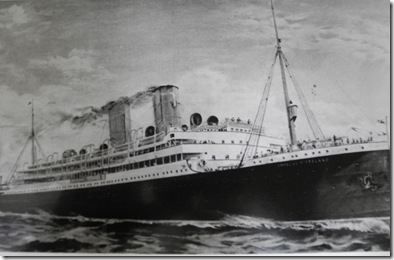The tragic sinking of the Empress of Ireland in the frigid waters of the St. Lawrence River during the early-morning hours of 29 May 1914 is sometimes referred to as “Canada’s Titanic.” Indeed, with the loss of 1012 lives, the parallels to the Titanic are appropriate. On the Titanic, 807 passengers drowned, while the Empress’ death toll was 840 passengers. The final number of deaths was higher on the Titanic, as a greater number of the crew perished.
The book, “The Pathway of Duty,” tells about the struggles of the Aldridge family, that immigrated to Canada from Britain in 1907, and settled in Toronto. Ernie Aldridge, the father of the family, on a return voyage to his native land, drowned aboard the Empress of Ireland. When a collier rammed The Empress, it sank within fourteen minutes. The quote below describes the magnificent vessel
The Royal Mail Steamer, The Empress of Ireland, was a sight never to be forgotten. Launched in Glasgow in 1906, the twin propeller-vessel was sleek to the waterline, designed with an elongated torpedo shape. It was capable of speeds exceeding twenty knots, which is about twenty-three land miles per hour. It was propelled by two gargantuan “quadruple, expansion, steam engines,” individually weighing five hundred tons, each containing four cylinders. The largest of the cylinders on the engines was over six feet in length. The engines were thirty feet high, reaching to the engine room skylights on the boat deck. The casting of these engines was a feat in itself. Lloyd’s of London had conferred on The Empress a safety status number of one hundred, the highest rating possible.
There were other remarkable statistics about The Empress. It required almost a full week’s labour to load the 2600 tons of coal to create the heat for the boilers. Almost the same amount of time was needed to replenish the food and other supplies on board. The massive hull of The Empress was coal-black, except for a narrow band of scarlet red at the water line. The top decks were gleaming white, and on the morning it set sail, they reflected the sun’s rays. Two towering copper-coloured funnels, rimmed at the top with solid black bands, stretched high into the air. The bow was acutely pointed to slice through the water with as little resistance as possible. The stern was schooner-shaped, a pleasing reminiscence of the sailing days of the past when wooden vessels were the rulers of the seas, though now it was the era when the great ocean liners had assumed command. Anyone that saw the The Empress felt that it thoroughly deserved her regal name.
On the morning that the ship was to sail, the arrival of the passengers created a great deal of activity, as over a thousand passengers were booked, as it was approaching the high season for tourists. The third-class (steerage) section was full, whereas the second-class was about half occupied. Only the first-class section had plenty of space since it was two-thirds empty.
Loading the passengers’ luggage was a formidable task, since for this particular voyage it is likely that over 3000 pieces of luggage were involved. From the CPR shed, baggage handlers took the steamer trunks and piles of luggage, and carted them down the gangways on two-wheeled dollies, the workers resembling a long line of constantly moving ants. When the passengers arrived at the end of the gangway, they were greeted by an officer from the ship. From there, the passengers gave instructions for the storage and handling of their luggage. For the bags not required during the voyage, tags labelled “unwanted” were attached, and they were then delivered to the storage hold. Smaller suitcases containing personal items and clothing needed in the days ahead were given tags labelled “wanted” and these were carried directly to the cabins by the “hall” stewards.
The steamer was a technological marvel, representing one of the finest achievements of the Edwardian age. It was one of the few ships that provided direct train service, complete with sleeping cars, directly from Toronto to ship side in Quebec. Travellers thought so highly of the quality of the ship, that the June 25th sailing was already well booked.
A link to read about the memorial service held each year in Toronto on the anniversary of the tragedy: https://tayloronhistory.com/2011/05/30/service-to-honour-victims-of-the-empress-of-ireland/
